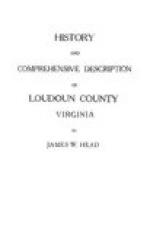FAUNA.—Wild ducks, geese, and turkeys, pheasants (English and Mongolian), partridges and woodcock are among the game fowls of Loudoun, and eagles, crows, buzzards, owls, and hawks among the predatory. The usual list of songbirds frequent this region in great numbers and receive some protection under the stringent fish and game laws in force here.
Red and gray foxes, raccoons, opossums, woodchucks, squirrels, hares and smaller animals are quite general.
In pioneer days the county abounded in the larger species of game common to the forests of North America. Among these were the beaver and otter, buffalo, deer, wolf, wild-cat, panther, bear, fox, and elk or wapiti (Cervus canadensis), noble herds of which ranged the mountain sides and valleys of this section.
TRANSPORTATION FACILITIES.[13]
Good roads, always of immeasurable importance to the farmer, were early made necessary by the tremendous crops of marketable products harvested from Loudoun lands. Though this need, in time, became imperative the roads were never hastily and imperfectly constructed; they were built with an eye single to permanence and with due allowance for generations of unintermittent and augmentative traffic.
These roads yielded their promoters modest dividends, but with the completion in 1832 of the Chesapeake and Ohio Canal, bordering the county just across the Potomac, transportation to and from Washington (Georgetown) and Alexandria was materially cheapened and the earnings of the turnpike companies suffered a corresponding decrease, the income, in many cases, being barely sufficient to defray the expense of maintenance. Tolls are now collected at only two points, in the County.
[Footnote 13: No apology is offered for the omission of vital statistics that might and would have been included in this department had earnest appeals addressed to State officers and the State Corporation Commission met with more courteous and, I might add, dutiful consideration. Not the least assistance was vouchsafed by any of them.—THE AUTHOR.]
The turnpike craze spread to Loudoun not long after the War of Independence and culminated about forty years later. It wrought a revolution in public travel, relatively nearly as great as that brought about by the railway craze in more recent years. The corporate names of some of the roads constructed through Loudoun before its subsidence were, the Goose Creek and Little River Turnpike, Loudoun and Berlin (now Brunswick, Md.) Turnpike, Ashby’s Gap Turnpike, Leesburg Turnpike, Leesburg and Snicker’s Gap Turnpike, Little River Turnpike and Snicker’s Gap Turnpike. Their combined authorized capital stock was $637,325, of which amount more than two-thirds was subscribed by individuals, the State assuming the balance.




